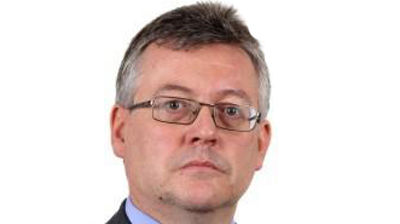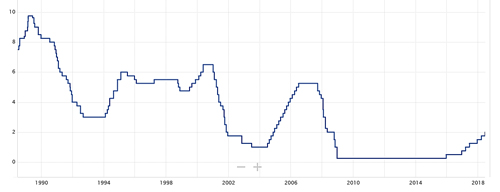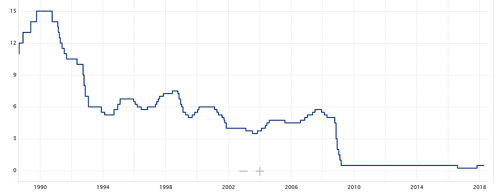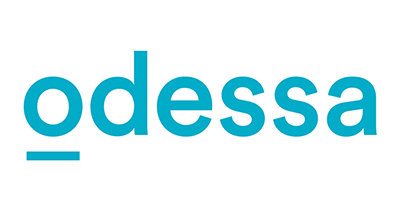
Asset finance companies have been urged to prepare for higher interest rates as global economic growth makes increases more likely.
Rhys Herbert, senior economist for Lloyds Banking Group, said economies are now “at a turning point” for interest rate rises, a decade after rates were slashed as governments battled the impact of the global recession.
Speaking at the UK’s National Association of Commercial Finance Brokers Expo recently, he said: “I think we will start to see a turnaround in interest rates everywhere.”
The US economy has been leading the way with recent announcements that have taken the base rate from 0.25% in steps to its current level of 2%.
US interest rates

Source: IECONOMICS
However, this remains historically low compared to an average of around 5%.
Herbert added: “The US is ahead of the curve, but the international environment is changing and that will have a knock-on effect.”
For the UK, an interest rate hike is predicted in August from the current level of 0.5%, with Rhys saying future annual rises could take it to 1.5% by 2019/2020.
UK interest rates

Source: IECONOMICS
This is also low by historic standards, as the UK’s all-time average interest rate is 7.6%.
As the low interest rate environment nears the start of its second decade, it means that an increasing proportion of consumers and businesses have never experienced a higher interest rate environment.
Herbert added: “We are at, or past, a turning point for interest rates.
“Central bankers are starting to turn the tap off for quantitative easing as well, which helped keep interest rates down.
“The Americans have already done so; the Europeans have indicated that they will do so by the end of the year.
“So, all of this is changing the global interest rate environment and that is starting to have an impact on market interest rates.
“It's not going to be just government interest rates that start to turn around, it's market interest rates as well.”
The impact of Brexit creates a more complex environment for the UK, as exchange rate fluctuations saw the value of sterling fall 20% following the UK’s vote to leave the European Union.
While this is adding to the industrial cost base, with a substantial rise in import costs, UK manufacturing had a strong year in 2017 as exports became more competitive because of the weak exchange rate, Rhys said.
He added that the environment could be summarised by “the good, the bad and the ugly”, with strong exports classified as good news, as export orders will perform strongly for at least another year.
However, the bad news is that Brexit-related uncertainty is limiting investment.
Herbert said: “Normally, this stage in the economic cycle is when you would expect business investment to be strong. That has not happened this time.
“When you ask people why, the main reason is economic uncertainty, and this is where Brexit raises its head.”
He pointed out this was bad news for the economy because it takes away from economic growth and in the long-term it will hit productivity.
In addition, consumer spending figures are “pretty ugly”.
“We went very quickly from boom-like conditions in UK economic growth in 2016 to a big slowing in consumer spending growth last year,” Rhys said.
Higher inflation and economic uncertainty have dampened demand.
Although growth may be helped by the economy enjoying the highest levels of employment for decades, a lack of skilled labour could push up wages and lead to further upward pressure on inflation.
Herbert added: “There are a number of factors that suggest interest rates will go up.
“They will go up slowly and remain at low levels by historic standards, but you do need to plan for interest rates being higher than they have been in the recent past.”

